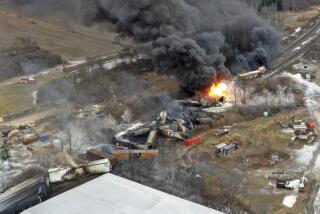Can Homeland Security Plan Make Us Safe?
President Bush’s proposal to create a Cabinet-level Department of Homeland Security is a step in the right direction in that it would improve how the government is organized to prevent terrorism. But that alone won’t do it. The plan doesn’t adequately protect our most vulnerable sites or do enough to keep those who would harm us from our shores.
Since terrorists will always look for our weakest points, Congress needs to figure out where the shortcomings in Bush’s new proposal may reside and fix them.
Providing robust homeland security requires multiple levels of effort, including keeping dangerous people and materials out of the country and preventing any terrorists who reach U.S. soil from undertaking attacks by limiting their access to dangerous materials or by arresting or deporting them before they strike.
It also requires the protection of our most vulnerable sites against violence. And, if all this fails, reducing the human and economic consequences of any attacks that occur.
Bush’s plan includes good elements, such as its mechanisms for coordinating intelligence efforts. But it risks repeating some of the flaws found in his budget proposal for homeland security for 2003, released four months ago and still under review by Congress: It puts too little emphasis on protecting vulnerable targets and preventing terrorists from getting their hands on dangerous materials.
Consider some of the preventive measures that are essential for improved homeland security that have not yet received high-priority attention from the administration: ways of preventing biological agents from being introduced into the air intake systems of major buildings and other large facilities, higher standards of security for plants producing toxic chemicals, safeguards on trucks carrying hazardous materials and background checks on their drivers, and major improvements and expansions in the Coast Guard and Customs services, largely for monitoring containers entering the country.
Most of these measures are hard to implement because they require cooperation between the private sector and the government.
Most of the assets in the U.S. requiring protection or monitoring are privately owned, yet the government has responsibility for protecting the country as a whole from attacks that could kill large numbers or badly damage the economy.
How can this type of cooperation be encouraged and enhanced?
One approach would be for the government to pay for the required security measures itself, even when they involve private firms. This would be unreasonably expensive for the federal budget.
Or the government could mandate that private owners take specific steps to better protect their firms. But that could be overly burdensome and ineffective.
The most cost-effective approach would probably be a combination of performance-based regulation with insurance coverage, similar to the system used for homeownership.
Local building codes specify minimum standards that homes must meet. That is the regulatory component.
But mortgages also generally require homes to carry insurance, and insurance companies provide incentives for improvements beyond the building-code level--for example, by reducing premiums if the homeowner installs a security system.
Similarly, in homeland security, regulations should provide a backstop of protection, while the insurance market could spread information about best practices and provide a direct financial incentive to improving security.
Developing these kinds of measures is a complex task. It is also at least as important as restructuring Washington’s bureaucracies.
The good news is that Homeland Security Director Tom Ridge’s office is still working on a strategic plan for protecting the homeland. That plan is due in July, though reports suggest that its release will be postponed until the fall.
The bad news is that Bush, by highlighting his reorganization plan so prominently, could make us focus too much on government charts in the coming months and not enough on protecting the country.
More to Read
Sign up for Essential California
The most important California stories and recommendations in your inbox every morning.
You may occasionally receive promotional content from the Los Angeles Times.










